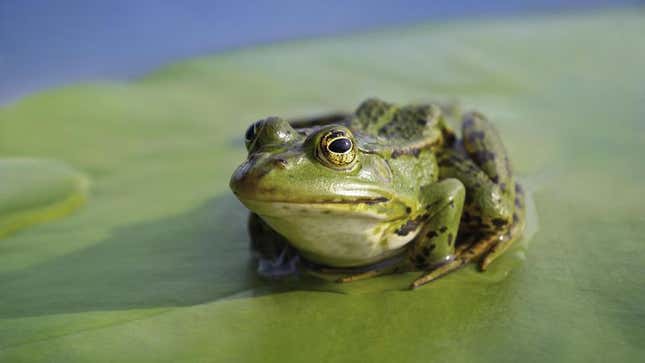
EARTH—Declaring that they had occupied a low-level rung in the global ecosystem for far too long, the world’s frogs revealed Thursday an ambitious 5-million-year plan to move up the food chain.
According to frogs, the long-term, multipronged strategy will include a series of dietary, cognitive, behavioral, and morphological adaptations designed to help them as they evolve to inhabit a higher place in the biosphere’s order of predation. Provided they adhere to the developmental benchmarks they set out and run into few obstacles, frogs said they ultimately envision themselves at a tier of the food chain on par with hawks and ocelots.
“We recognize that this is a major undertaking for our kind, but we believe we frogs are more than up to the challenge, and 5 million years from now, we are extremely confident that snakes will no longer be eating us—we’ll be eating them,” said a red-eyed tree frog, who spoke on behalf of all 4,800 unique species belonging to the taxonomic order Anura, explaining that their first course of action would be to double in size. “Right now, we prey on flies, moths, crickets, and maybe a worm here or there, but mostly just assorted bugs. We no longer consider this acceptable. Under our new plan, we see ourselves regularly consuming rodents, lizards, rabbits, and, if everything goes as anticipated, bats.”
“Being amphibious means we can go after prey on both land and water, and we really think that’s a trait we can leverage.”
“We recognize that such a diet will require pointed teeth as well as powerful jaws, and it is our intention to evolve these attributes on the fixed schedule we’ve laid out,” the frog continued. “As you can see on our timetable, we’ll start in on growing incisors in the near future.”
Noting that they’re “already pretty good at lunging,” frogs explained that the first phase of their plan, expected to take place over a 600,000-year period, will include a 400 percent increase in muscle mass, allowing them to leap high enough to take out small, low-flying songbirds and, eventually, ducks.
In addition, frogs have indicated that by the 2-million-year mark, they will make use of selective breeding to lengthen their rudimentary teeth into long, cobra-like fangs. This, along with the introduction of claws in their forelegs, will give them the opportunity to reverse the longstanding predator-prey relationships they’re currently engaged in with animals such as bass, shrews, otters, and turtles. The frogs’ timetable also includes an assessment of the claws after 2.6 million years to determine whether they should be made retractable.
While frogs confirmed their intention to continue capturing prey by shooting out their tongues, they expressed their desire to add some sharp barbs or a forked appearance to the appendage to give them the menacing appearance of “a true predator.”
“We haven’t decided whether we’re going to hunt in packs yet, but it’s certainly something we’re considering,” said a North American wood frog, describing how in the future, teams of frogs might stalk hoofed mammals through a forest, flush them out of their hiding places, and then pounce upon them all at once. “We saw wolves doing this kind of thing and thought, ‘Why not us?’ It’s ambitious, but we like our chances of pulling it off.”
“It goes without saying that we’ll first need to develop the capacity to rotate our heads from left to right, though,” it added.
The tailless, moist-bodied amphibian went on to confirm reports that any hunting initiatives conducted against much larger faunae would be led by members of the poison dart frog community.
Several frogs told reporters they were first inspired to rise up the ranks of the food chain by the shark, which they described as “the ultimate hunter-killer,” saying they eventually hope to establish a longer-term plan that would allow them to one day match the aquatic predator’s impressive speed of up to 30 miles per hour and its bite force of several hundred pounds per square inch.
While frogs stressed they currently harbor no intention of becoming apex predators, they pointed to one evolutionary advantage they believe could allow them to rise dramatically in nature’s pecking order.
“Being amphibious means we can go after prey on both land and water, and we really think that’s a trait we can leverage,” a Malayan horned frog said. “If a land mammal tries to escape from us into a river or pond, well, guess who has the upper hand in aquatic environments? Similarly, if a bunch of sea lions are sunning themselves on land, clambering around on their flippers, we can sneak up under cover of water, hop ashore, and rip them to pieces.”
“Frankly,” the frog continued, “we’ll be the perfect killing machines.”
At press time, billions of frogs around the world were reportedly sitting on lily pads and trying their hardest to grow razor-sharp talons.